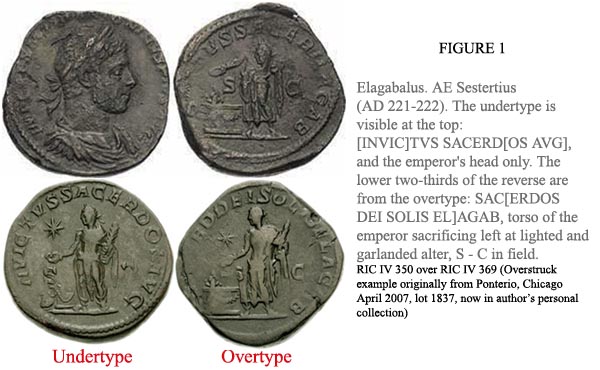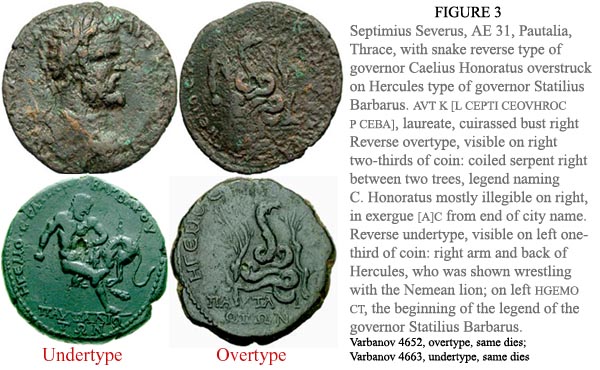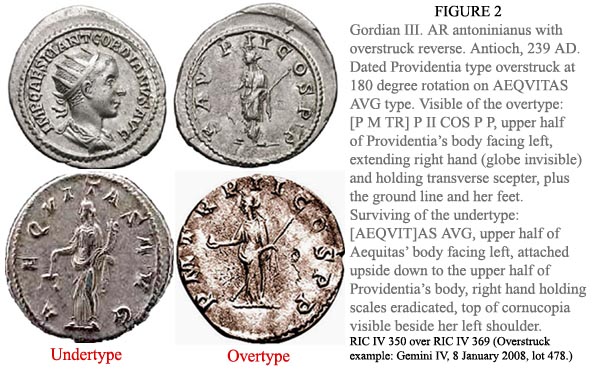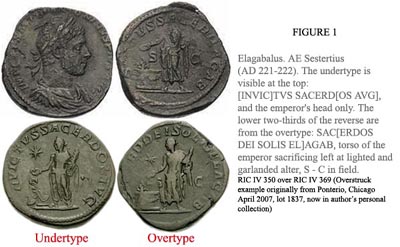|
|
| |
 |
|
From the late first to the mid third century AD, both Roman bronze coins (sestertii and middle bronzes, (Figure 1) and Roman provincial bronze coins (Figure 3) quite often show a peculiar striking error: their obverses are normal, but their reverses are overstruck, either with two different dies of the same type, or with two different types that were however apparently in use simultaneously. Much more rarely, Roman denarii and antoniniani of the same period show this error too (Figure 2). Such overstrikes are individually rare, but they occur on the coins of so many different emperors and so many different cities over such a long span of time, and with such relative frequency, that they cannot be dismissed as mere freaks or jokes of a bored moneyer, but must instead reflect some fault or peculiarity of the striking process which caused their production. |
|
| |
|
| |
The probable explanation of this phenomenon occurred to Colin Kraay in the early 1970s, when he and I were discussing an overstruck As of Caracalla of this sort, which had just been acquired by the Ashmolean Museum in Oxford: it would appear that two different reverse dies were being applied alternately and at rapid speed at one and the same obverse die, and the overstrikes occurred when a finished coin was erroneously not removed from the obverse die and replaced by a fresh blank as intended, so was struck with the second reverse die before the workman responsible could notice the mistake and interrupt his routine.
Possible reasons for adopting this method of production might have been to speed up the rate of production at each obverse die, and to prevent overheating of the reverse dies, since each of them was only used to strike every other coin. |
|

|
|
| |
|
 |
|
Colin Kraay never published this idea, but I have discussed it numerous times since joining Harlan J. Berk, Ltd. in 1994, for example on the Yahoo discussion forum Moneta-L, in the Forvm Ancient Coins Discussion Group, and in Berk Buy or Bid sales or auction catalogues, e.g. Gemini IV, 8 January 2008, lot 478.On the coin of Septimius Severus at Pautalia shown in Figure 3, it is curious that the two overstruck reverse dies name different governors, Caelius Honoratus and Statilius Barbarus. We must suppose that at the end of the term of office of the first governor, at least one of his reverse dies was still in good shape, so was retained in use under his successor, for whom however new reverse dies with his own name had also been engraved. We cannot conclude that Honoratus must have succeeded Barbarus in office, since Honoratus' reverse die was struck over that of Barbarus; rather the two reverse dies were in use simultaneously, and the order in which they were used to produce the misstrike was pure chance! |
| |
|
| |
|
|
| If Kraay's explanation of these overstrikes is correct, it has two interesting consequences. First, we can conclude that any two reverse types found overstruck on the same coin must necessarily have been in use simultaneously. That will be valuable information in our attempt to reconstruct the original order of the mint's production of the various types. Second, it cannot be correct that different reverse types were always produced in different workshops at the mint, as many modern scholars have suggested. On the contrary, different reverse types were apparently often struck simultaneously at one and the same anvil! |
|
 |
|
| |
|
|
|
|
|
| Copyright 2008-2009 Imperial Coins & Artifacts, Inc. |
|
|